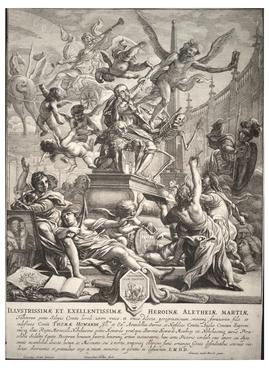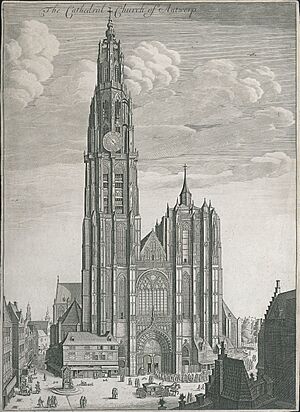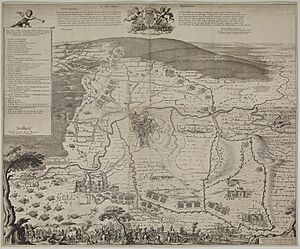Wenceslaus Hollar facts for kids
Quick facts for kids
Wenceslaus Hollar
|
|
|---|---|
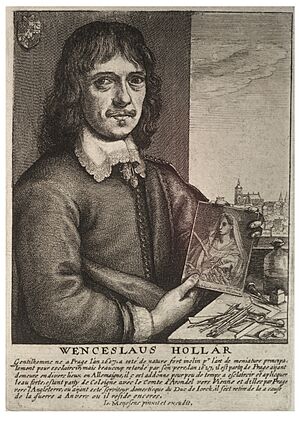
Portrait etched by Hollar after an original by Jan Meyssens, c. 1649. Prague Castle is in the background.
|
|
| Born |
Wenzel Hollar
23 July 1607 |
| Died | 25 March 1677 (aged 69) |
| Nationality | Bohemian |
| Known for | Etching |
| Movement | Baroque |
Wenceslaus Hollar (born July 23, 1607, died March 25, 1677) was a very talented artist from Bohemia. He lived in the 1600s and spent most of his life in England. In German, his name was Wenzel Hollar. In Czech, it was Václav Hollar. He was famous for his detailed engravings and etchings. Hollar was born in Prague and later died in London.
Contents
Hollar's Early Years
Hollar's family lost everything during the Thirty Years' War. This war caused a lot of damage, especially during the Sack of Prague. Young Hollar had planned to become a lawyer. But after his family's troubles, he decided to become an artist instead.
His earliest known artworks are from 1625 and 1626. These were small plates, including a copy of a "Virgin and Child" by Albrecht Dürer. Dürer's art greatly influenced Hollar throughout his life. In 1627, Hollar moved to Frankfurt. There, he learned from a famous engraver named Matthäus Merian.
By 1630, Hollar lived in different cities like Strasbourg, Mainz, and Koblenz. He drew many towns, castles, and beautiful landscapes along the Middle Rhine Valley. In 1633, he moved to Cologne.
Meeting Lord Arundel
In 1636, Hollar met Thomas Howard, 21st Earl of Arundel. Arundel was a very important nobleman and loved collecting art. He was on a special trip to see Emperor Ferdinand II. Arundel hired Hollar as a draftsman, which meant Hollar would draw things for him. Hollar traveled with Arundel to Vienna and Prague.
In 1635, while in Cologne, Hollar published his first book. In 1637, he went with Lord Arundel to England. Hollar lived and worked in Arundel's home for many years.
Life in England
Even though Hollar worked for Lord Arundel, he also took on other jobs. After Arundel died in 1646, Hollar started working for different writers and publishers. This became his main way to earn money. He even made a special print to honor Lord Arundel after his death.
In 1641, Hollar married a woman named Tracy. She worked for the Countess of Norfolk. They had two children together. Lord Arundel left England in 1642. Hollar then began working for the Duke of York. He took his young family with him.
English Civil War
Hollar kept making many artworks during the English Civil War. However, the war made it hard for him to earn money. He was with other artists who supported the King, like Inigo Jones. They were all part of the long siege of Basing House. Hollar made about 100 plates during 1643 and 1644. This shows he used his time well, even when stuck in the siege.
One etching from 1643, called civilis seditio, showed the war. It had a snake with two heads pulling in opposite directions. This was in front of the Giza pyramids and sphinx. This picture showed the long-lasting impact of the war.
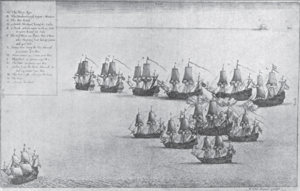
Hollar joined the Royalist army. In 1645, he was captured by the other side during the siege of Basing House. But he managed to escape soon after. In 1646, he met Lord Arundel again in Antwerp. During the war, Hollar worked in Antwerp. He created many famous works there. These included city views of Dutch towns, seascapes, and pictures of nature.
In 1652, Hollar returned to London. He lived for a while near Temple Bar. In the years that followed, he illustrated many books. These included works by John Ogilby and William Dugdale. But the pay for these jobs was low. After the King returned to power (the Restoration), Hollar's work was not bought as much by the Court. During this sad time, he also lost his young son to the plague. His son was said to have artistic talent too.
After the Great Fire of London, Hollar made some of his famous "Views of London." These pictures of cities, like his 1649 Great View of Prague, were very popular. Because of this, the King sent him to Tangier in 1668. His job was to draw the town and its forts.
On his way back to England, his ship, the Mary Rose, fought a brave battle. Under Captain John Kempthorne, they fought against seven Algerian warships. Hollar later etched this battle for a book called Africa.
Hollar lived for eight more years after returning. He continued to make illustrations for booksellers. He also created other well-known works, like a large picture of Edinburgh from 1670. He died very poor. His last words were a request to the people collecting his debts not to take the bed he was dying on. Hollar was buried near St Margaret's Church, Westminster.
Hollar's Artworks
Hollar was one of the most talented and active artists of his time. He made about 400 drawings and 3000 etchings. His works included views of places, portraits of people, ships, religious scenes, and landscapes. He also drew still life pictures, which are drawings of objects.
Some of his projects were very large and detailed. For example, he made an eight-plate series called Portuguese Genealogy. He also created a 12-plate series of insects. His drawings of buildings, like the cathedrals in Antwerp and Strasbourg, were very accurate. They were also beautiful pictures. He copied decorative works by other artists too. One famous example is a chalice based on a drawing by Andrea Mantegna.
One of Hollar's most famous etchings is a picture of the Cathedral of Our Lady of Antwerp, made in 1649. This artwork shows a lively scene. There is a procession going towards the cathedral entrance. You can also see a horse-drawn coach, people walking by, and dogs in the square. This picture was shown in an exhibition in 2013.
Hollar was also known for his maps and drawings of places. He often made these based on designs by other artists. He created some maps of battles, which were drawn by the artist Jacob van Werden. One example is the Siege of Landrecies from 1648. This etching shows a plan of the city of Landrecies during a siege. It also shows the different armies and their positions around the city.
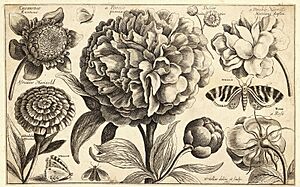
Hollar also engraved a book about clothes. It was called Livre curieux contenant la naifve representation des habits des femmes des diverses parties du monde comme elles s'habillent a present. This means "Entertaining book containing the simple depiction of the clothes of women from different parts of the world as they dress now." The book had 28 plates showing the clothing of women from different countries in the 1600s. It was published in Paris in 1662.
Where to See Hollar's Work
Many of Hollar's works are kept in famous collections. You can find them at the British Museum in London and the print room at Windsor Castle. The Thomas Fisher Rare Book Library at the University of Toronto also has a collection. Other places include the National Gallery in Prague and the Virginia Museum of Fine Arts.
A very rare original copper plate made by Hollar still exists. It is an engraving of the city of Kingston upon Hull in Yorkshire. This special plate is kept in the British Library.
Legacy
The Výtvarná škola Václava Hollara (Wenceslaus Hollar Secondary School of Art) in Prague is named after him. It is a high school and higher art school.
|



